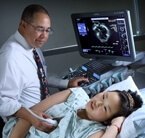
In caring for Emily Yang, says William Ravekes, “what has been great is the collaboration of pediatric oncology, pediatric and adult cardiac surgery, and both pediatric and adult intensive care.”
Emily Yang’s case was as clinically complex as cardiac care gets. Diagnosed with osteosarcoma, the 14-year-old from Virginia underwent below-the-knee amputation of her left leg and chemo and radiation therapy. But the chemotherapy took a toll on her heart and lungs, and on the Thanksgiving eve following her surgery, Emily could hardly breathe. In Johns Hopkins Pediatric Emergency Department, pediatric cardiologist William Ravekes gave Emily and her mom the news—Emily was in heart failure with severe left ventricular dysfunction and had an acute viral infection.
“Her heart was vulnerable from the chemotherapy, and getting the viral infection seemed to have pushed her right over the edge,” says Ravekes.
Emily’s ejection fraction was a mere 12 percent. Moreover, because her cardiac output was worsening, she was admitted to the pediatric intensive care unit (PICU) and placed on extracorporeal membrane oxygenation by pediatric cardiac surgeon Luca Vricella.
After nine days on ECMO, Emily’s lungs improved, but her heart needed the support of both a left ventricular assist device (LVAD) and a right VAD, a so-called tandem heart. Emily also needed an aortic balloon pump implanted to improve blood flow.
“The balloon pump inflates during diastole to force blood flow back into the coronary arteries and also forward to give a little more oomph for blood moving to the liver, the kidneys and everything else,” says Ravekes. “It’s a rare surgery in kids, but she needed it because both her ventricles were so dysfunctional.”
Cardiac surgeon Ashish Shah carried out the complex operation and admitted Emily to the adult ICU, where staff are more experienced in caring for bi-VAD and intra-aortic balloon pump patients. After three days, Emily’s right ventricle recovered and she was taken off the RVAD and balloon pump and transferred to the PICU under the care of critical care specialist Kristen Nelson. Her weakened left ventricle required her to stay on the LVAD, but because the device was implanted she was able to go home.
Since then, Emily has attended regular school and resumed playing the guitar and piano. Meanwhile, her team has been monitoring her left ventricular function to determine whether she needs a new heart. If in a year there are no signs of recurring cancer, Ravekes says, Emily could be placed on the heart transplant list.
“If her heart function is still severely depressed, she would stay on the LVAD,” says Ravekes. “If the function is better but still marginal, we would support her with medications and put her on the transplant list but remove the device. If her heart is functioning really well, we’ll keep transplant on the back burner as long as possible—there is a possibility that she could avoid it.”
##
